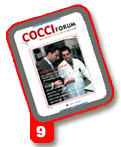COCCI Profile: Feed for Thought
Coccidiosis vaccination gives Spain's AVILESA more flexibility with broiler management.
 Dr. Juan Pablo Perez. 'I was concerned that more pathogenic strains of Eimeria were developing.' |
AVILESA had several good reasons to make vaccination part of its coccidiosis management
program in standard broilers. The Spanish poultry producer's most immediate
goal, however, was to stop the continuous use of in-feed anticoccidials and reverse what management felt was a growing resistance problem.
"Some anticoccidials simply were not working as well as they used to," says Dr. Juan Pablo Perez, a veterinarian in charge of nutrition and anticoccidial programs at AVILESA, or Avicola Levantina, S.A., based in Murcia, Spain, about 230 kilometers (143 miles) south of Valencia near the southeastern coast.
"Even though we used them in carefully planned shuttle programs, I was concerned that more pathogenic strains of Eimeria were developing and that the disease would become more difficult and costly to control. I know that in flocks with subclinical coccidiosis, average daily gain and feed conversion can be just awful. We needed to make some changes before any major setbacks occurred."
After conducting a few trials, AVILESA decided to vaccinate standard broilers with Paracox-5 for at least two cycles to give traditional anticoccidials a much-needed rest. He then planned to go back to using in-feed anticoccidials.
Today, some 3 years later, coccidiosis vaccination has become an essential part of the coccidiosis management program at AVILESA, which processes some 12 million birds a year. The vaccine is administered in the hatchery to day-old birds. A specially designed SprayCox spray cabinet ensures uniform distribution and development of attenuated oocysts, which stimulate natural immunity in the birds and provide lifetime protection.
Kicking the drug habit
For AVILESA, vaccinating for coccidiosis is also helping the company reduce drug usage without compromising the health or the performanceof the birds.
"Consumers today take a lot of interest in how their food is raised," says Dr. Juan Martinez, a field veterinarian working at AVILESA's four company- owned farms, which are spread over 3 kilometers (1.8 miles) in Jumilla in the shadow of the Sierra del Molar.
"Whether their concerns have scientific merit or if they are just responding to a story they read in a newspaper, we know they are worried about drugs in animal feed."
Perez agrees. "As a company, we need to be sensitive to consumers' demands. Vaccinating for coccidiosis is helping us produce healthy broilers while reducing drug usage."
So far the decision to vaccinate appears to be meeting AVILESA's needs as well. In terms of feed conversion and average daily gain, performance of vaccinated birds is as good as that of birds on medicated feed, Martinez says, noting that average daily gain is about 56 grams (0.123 pound) in mixed-sex houses.
"More importantly, we found that traditional anticoccidials perform better when used in a rotation with a coccidiosis vaccine," he says.
Filling a void
 Vaccinated broilers at AVILESA's company-owned farm. |

Field veterinarian Dr. Juan Martinez and farm manager Miguel Angel Cano. |
The boost in anticoccidial performance has been especially helpful following the EU's ban of nicarbazin in May 2002,
adds Perez.
"Nicarbazin was routinely used in shuttle programs and helped the infeed anticoccidials work better," he
explains. "Without this additive, we need to be more careful with the anticoccidials
that are still available to us. Using a vaccine in our program helps keep the anticoccidials working. We
don't have subclinical coccidiosis problems. And when you don't have coccidiosis, your birds will perform better
in all areas.
" Throughout the world, coccidiosis vaccination is expected to play an even bigger role in the future as more poultry companies see how the practice can add flexibility to nutritional programs.
Because vaccinated birds are free from the constraints imposed by drug withdrawal times, companies can build feed programs around the nutritional needs of the birds, not the withdrawal times of in-feed anticoccidials.
For example, instead of feeding a withdrawal or finisher feed to the birds for the last 5 to 6 days, AVILESA is considering using this lower cost feed earlier in the flock's life "possibly at 30 days "to reduce costs without risking a late coccidiosis outbreak.
"Extending the withdrawal feed is something we definitely want to look at," Perez says. "We want to produce a very high quality carcass. Our slaughter house therefore wants us to use a fixed amount of fat in the carcass, and that
fat is given to the birds in the fourth feed for a fixed period of time. We would need to make adjustments to that if we extended the length of the withdrawal feed.
"At this time," he continues, "we also want to keep the antibiotic growth promoter in the feed while it is still available to us. But certainly, we have seen the latest research in this area of broiler nutrition. Extending the time for the low-cost withdrawal feed is an exciting, cost-saving option we'll consider for the future."
Making adjustments
 Dr. Cesar Carnicer of Schering-Plough Animal Health, AVILESA's field veterinarian Dr. Juan Martinez and farm manager Miguel Angel Cano. |

AVILESA's four company-owned farms are located in the shadow of Sierra del
Molar for optimum biosecurity. |
From a management standpoint, switching to coccidiosis vaccination did not require any major changes at the farms, but Perez acknowledges that removing in-feed anticoccidials may open the door to more enteric pathogens. He is not worried, however, because his feed mill can compensate by making adjustments to the nutritional programs of vaccinated birds.
After making coccidiosis vaccination part of its program, AVILESA discovered one more significant benefit: greater marketing flexibility.
For example, at its four companyowned farms, which have a capacity
for 700,000 birds, the company grows standard broilers of 2.8 to 3.0 kilograms (6.2 to 6.6 pounds) in 48 to 50 days.
However, at 36 days, AVILESA thins out the flock and markets some birds weighing 1.9 kilograms (4.2 pounds)
for small roasters.
"When birds are vaccinated for coccidiosis, the farm manager doesn't have to worry about withdrawing medication
from the feed and leaving birds unprotected," Martinez explains.
"Now we can put all of the broilers on the same feed and market lighter birds whenever they are in demand," adds farm manager Miguel Angel Cano. "They're much easier to manage."
Cano says this added flexibility is particularly beneficial to AVILESA's feed mill because the company uses only one feed truck and driver for each farm for added biosecurity. When broilers are on medicated feed for coccidiosis, he says, the mill has to ship separate feeds for the birds that will be marketed early.
Reduce Costs, Maintain Production |
Looking ahead
Adding a vaccine to AVILESA's coccidiosis- management program has also helped the company develop a more strategic, long-term strategy for controlling the costly disease.
"Rather than select treatments as we go along, we already know what our coccidiosis program will be 12 to 18 months from now," Perez says. "We know how the different feed products work. We know how the vaccine works. We can create a program that employs the strengths of each product."
For example, Perez says, in late autumn and early winter, Eimeria organisms tend to grow and multiply much faster than in the hot, dry months of summer. AVILESA therefore rotates to the vaccine in the fall to introduce a controlled dose of attenuated oocysts that stimulate the natural immunity to coccidiosis.
"If we are going to have rapid growth of Eimeria oocysts, we want them to be from the vaccine, not from the wild oocysts in the field that can lead to resistance," he says.
Coccidiosis vaccine is also used in all of the company's free-range birds, which are grown to 3.5 to 3.7 kilograms (7.7 to 8 pounds) over 100 to 110 days.
Because their life span is more than twice that of standard broilers, all freerange chickens, or "camperos," are vaccinated for coccidiosis throughout the year. Continuous use of the vaccine also allows AVILESA to market these birds as being raised without medicinal feed additives.
"We see a lot of benefits from coccidiosis vaccination," Perez concludes. "It's helping us control the disease in our standard broilers and specialty market birds. At the same time, it is creating opportunities for us to improve the performance and efficiency in other areas of our operation. We are very pleased with the results of this program."
Schering-Plough Animal Health and IRTA have worked together to develop a new program called IDEA for managing the nutritional needs of birds vaccinated for coccidiosis. For more information, see Dr. Joaquim Brufau's article 'CHANGING PARADIGMS'.
Source: CocciForum Issue No.9, Schering-Plough Animal Health.







